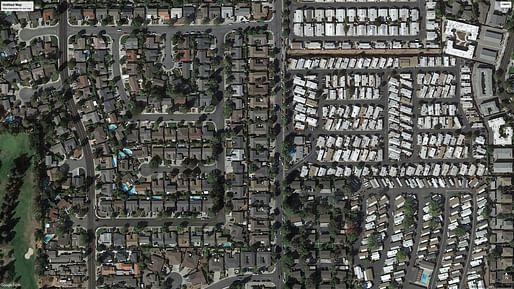

A group of North American professors is seeking to debunk commonly-held stereotypes about mobile home parks in the United States. City & Regional Planning Assistant Professor Zachary Lamb (University of California, Berkeley), Geography & Planning Assistant Professor Jason Spicer (University of Toronto), and City & Regional Planning Assistant Professor Linda Shi (Cornell University) hope that their defense of the typology will make mobile homes a “new face of affordable housing.”
“Over 20 million Americans live in manufactured housing — more than in public housing and federally subsidized rental housing combined,” the group says in their recent thought piece on The Conversation. “Yet many people, including urban planners and affordable housing researchers, see manufactured housing parks as problems. In contrast, we see them as part of the solution to housing crises.”
In response to the critique that manufactured housing is ‘shoddy,’ the group argues that manufactured homes have had to meet federal safety standards since 1976. “Today, new well-installed factory-built homes are comparable to site-built homes when it comes to standing up to wind, fire and other disaster threats,” they note, arguing that many quality problems associated with the typology are instead the fault of poor installation, park maintenance, and a lack of infrastructure maintenance.
The group also addresses the argument that manufactured housing parks are exploitative. Given that residents often do not own the land their home sits on, they can be vulnerable to predatory action by park owners, such as rent hikes, evictions, or poor maintenance of the land. In response, the group argues that a cooperative model could allow residents to jointly purchase their land, as has happened in over 1,000 manufactured housing parks across the U.S. already.
In response to critics that say manufactured housing parks are not urban or dense enough to address the housing crisis, the group notes that 61% of manufactured housing is located in metro areas, while the typical 8–15 homes per acre density of manufactured housing parks is often greater than nearby neighborhoods.
The group also disputes the argument that manufactured housing parks are uniquely disconnected from surrounding neighborhoods, noting that the same argument could be made of most post-World War II residential neighborhoods, including gated communities and cul-de-sacs.
“Decades of experience shows that resident ownership can transform manufactured home parks from sites of stigma and vulnerability into stable and resilient communities,” the group notes. “Governments could enact laws that offer tenants opportunities to purchase their rental units and provide subsidized loans and grants to resident cooperatives.”
9 Comments
The irony of this sort of effort is that when these were mobile home parks they were affordable. Gentrification started driving out lower income residents when well intentioned academics combined with park owners and manufacturers to eliminate the "stigma". Now these parks are trendy but priced well above what those on fixed incomes can afford. I'm sure the manufacturers and park owners are thanking you for your contribution to their bottom lines.
Very interesting topic and focus by some academics.
Difficult to imagine many others in the academy with anything but disdain for trailer park residents. And anyone with a southern drawl.
funny, I just watched a Vice documentary on YouTube about a company that buys trailer parks, jacks up the rent, drives the residents away, and then builds “affordable housing” that is several times more expensive than the original trailer park. What a racket. The city is In cahoots with these developers using code enforcement to justify the takeover.
Greed, for lack of a better word, is not good.
Greed is not good, but mandated altruism is simply obedient
*obedience. Morality requires the freedom to choose altruism over greed.
https://video.vice.com/en_us/video/wednesday-august-3-2022/62d84091a168f454c862b309
Humans will always default to greed, it just depends on what subset of shared traits they decide to use to define "us" and "them".
Interesting topic. While there is a stigma attached to mobile homes, better design could add a layer of infrastructure to make flexible living better. As you can see in the photos, much of the design problem / stigma seems to be lack of plug-in infrastructure. But what if there were better amenities, and organization for these -- more like camp grounds and better organization of people into community services.
There's a nice Lina Bo Bardi urban design drawing that sorta looks like it could be a trailer park -- more a modern suburban community in an alternate timeline.
https://arquitecturaviva.com/works/casas-economicas-7
Block this user
Are you sure you want to block this user and hide all related comments throughout the site?
Archinect
This is your first comment on Archinect. Your comment will be visible once approved.